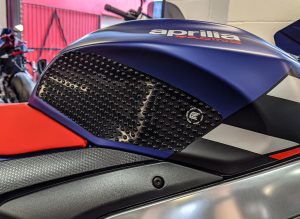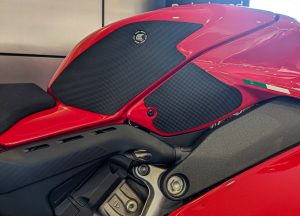


Our tank grips are designed as a permanent application and if removal is to take place, you need to be aware of one big issue – the sun has likely faded the surface around the grip more than underneath it.
Whilst it is unlikely that removal of any tank grip will permanently damage your bike’s paintwork, it is also important to understand that if the quality of the bike’s paintwork is poor to begin with, or you’re dealing with an older model, or the bike has been repainted or touched up, these will have an impact on removal.
It is also important to be aware that whilst most OEM graphics and logos should have an overlaminate or lacquered protective finish, this should be verified before tank grip removal is attempted.
Removing tank grips will vary in difficulty depending on the size and shape of the grip. Also, age can greatly affect how difficult it will be to remove. If removal is required, we suggest the following steps:
Dirt and debris on and around the grip can scratch your bike’s paint, so you’ll want to clean it beforehand. Get a cloth or a sponge and some soapy water and wash the grip and the surrounding area.
The next step is to heat up the grip to weaken and loosen the adhesive. The best tool for the job is a hairdryer, as a heat gun is too powerful and could damage your paintwork. Distribute the heat evenly throughout the grip and be sure to heat the edges of it. Give it a good two minutes of heating before you stop.
You’ll want to do this step immediately after heating up the tank grip. Have a plastic card on hand, like a rewards card or an old debit or credit card. Whatever you use, it should be plastic, as knives and razor blades can easily scratch the paint. A plastic card is strong enough to release the tank grip from the paint if you’ve heated it up sufficiently. Use it around all the edges of the tank grip with the card to try and release it from the bike. Once you’ve used the card to release the edges of the tank grip, you should be able to peel it off using your hand. A useful tip, is to use dental floss where the bond between grip and tank is a bit more stubborn, gently sliding the floss between the two surfaces in a sawing action. Remember to work in sections. You can start in one corner and you can work your way across it. Peel the grip back at an angle, this will also help in breaking the adhesive bond.
Most likely, once the tank grip is off, you’ll still have some adhesive residue on your tank. This is perfectly fine because there are plenty of products at your disposal that can get rid of it without damaging your paint. If you have some white distilled vinegar in your kitchen, grab that and apply it to a cloth to rub off the adhesive residue. Or, use an adhesive remover product like Goo Gone, which is a little more heavy-duty. Apply the product to a cloth and rub it onto the area or follow the instructions on the product label. WD40 is also effective as an adhesive remover.
© 2025 Eazi-Grip All Rights Reserved
Website Designed & Built by Stone Create